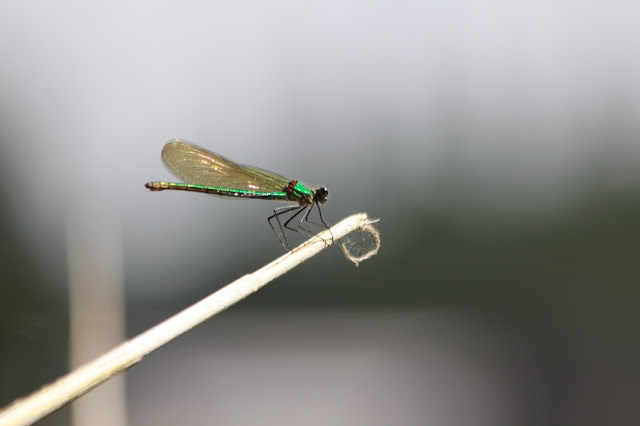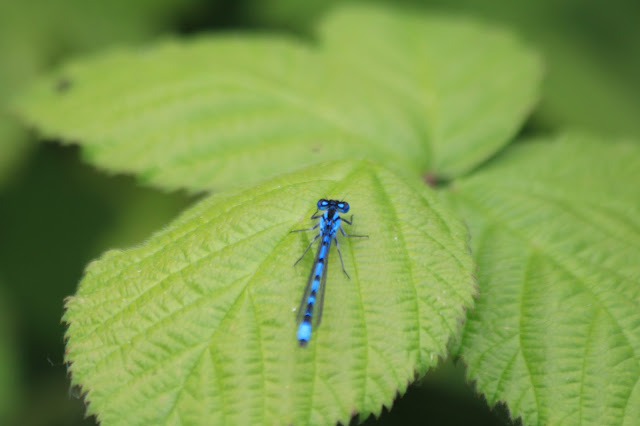A deadly voracious predator with the
ability to reach speeds of 30 miles an hour, move their wings independently and
catch insects in flight. A graceful enchanting flyer decorated with a range of iridescent
rainbow hues. It may not sound as though I am talking about the same creature
in these two sentences but that is part of the beauty of dragonflies and
damselflies, they are intimidatingly impressive yet exquisitely elegant.
 |
| Blue-tailed damselfly |
Since the beginnings of their ancestors
in the Late Carboniferous period, the Odonata (the taxonomic order which
consists of dragonflies and damselflies) have been a strong presence in marshes
and wetlands. They are incredibly widespread and have colonised every continent
with the exception of Antarctica.
 |
| Mating Common Blue damselflies |
Their dazzling adult form is tragically
transient and lasts merely days or weeks. Most of their lifecycle is spent
underwater in their nymph form. Although immature, the nymphs are none-the-less
impressive hunters and can dominate a freshwater ecosystem with their
aggressive predation skills.
 |
| Common Blue damselfly |
Living near fenland, we are lucky enough
to have a number sites in close proximity that are teaming with dragonflies and
damselflies. Two of the best are Wicken Fen and Paxton Pits. With abundant
areas of clean freshwater, rich with vegetation, they both provide the perfect
conditions for these incredible insects to lay their eggs and for their nymphs
to live until they are ready to emerge as adults.
 |
| Female Banded Demoiselle |
Many Odonata are sexually dimorphic
which can make identifying them trickier but, then again, doesn’t that just add
to the fun? One of the damselflies that we see most often, the
Banded Demoiselle, is a perfect example of this. The name is apt for the male
who has distinctive dark patches on his wings which shimmer like black velvet
alongside his azure body. However, the female does not display any of the bands
which provide her name. She has clear wings and a striking emerald body.
 |
| Male Banded Demoiselle |
The male Banded Demoiselle is one of the
easiest damselflies to identify seeing as there are only two British species that
appear to have coloured wings and the other, the Beautiful Demoiselle, has
fully tinted wings, without any bands.
 |
| Female Banded Demoiselle |
Another species of damselfly which
regularly makes an appearance on our walks is the Common Blue. This dainty
electric blue hued beauty is easily confused with the Azure damselfly. If you
look with binoculars or manage to get a good photo the identification becomes
easier as there are differences in the pattern of the antehumeral stripes on
their thoraxes.
 |
| Common Blue damselfly |
But enough of these diaphanous
damselflies and on to the beasts of the Odonata world – the dragonflies.
Without much knowledge of different species, by sight they can generally be
distinguished from damselflies by their larger, sturdier form. While they are
at rest another hint which will help you distinguish them is to look at the
position of their wings. Damselflies hold their wings alongside their body
while resting, while dragonflies position their wings out from their body.
Perhaps a more subtle difference to the naked eye is the relative size of their
wings to each other. While damselflies’ front and rear wings are similar in
size, dragonflies rear wings are wider than their front wings.
Damselflies may look deceptively placid
but, with their imposing size and strong flying skills, dragonflies are
unmistakably dynamic and charismatic. The Ruddy Darter cuts a particularly
striking figure alongside the undrained fenland on Wicken’s Sedge Fen trail.
This species’ searing scarlet body flashes brightly against the sepia toned
fenland vegetation, arousing images of the bleakly beautiful wildness of the
place.
 |
| Ruddy Darter |
The Four-spotted Chaser is another
striking, glitzy dragonfly which resides at Wicken Fen and in much of the UK.
As it hums past in a bronze blur you may not notice its most dazzling feature,
but as it gently rests upon the wetland flora you will easily see how it
procured its name. About halfway along and near to the tip of the leading edge
of each otherwise clear wing it has eye-catching ebony patches.
 |
| Four-spotted Chaser |
Subtler, yet no less extraordinary, is
the Black-tailed Skimmer. We spent an hour or so basking beside one of the
picturesque lakes at Paxton entranced by the aerial acrobatics of this
dragonfly and its gorgeous colourings which intensify down its body in an ombré
fashion from light blue to black.
 |
| Black-tailed Skimmer |
 |
| Black-tailed Skimmer |

No comments:
Post a Comment